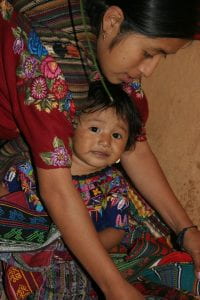By Halea Kerr-Layton, MA Global Communication ’21
Guatemala, the Central American country home to roughly 17 million people has unique vulnerabilities and challenges for public diplomacy presented by the competing narratives, identities, and experiences of its population. Specifically, between the indigenous and the non-indigenous, or Ladino, population. The inequality, repression and lack of political representation for the indigenous population presents a particularly unique environment that fans unrest and lends itself to disinformation. Through a brief examination of some of these narratives and realities, these vulnerabilities and challenges will be examined.

Two Competing Narratives
Whenever there are competing narratives or realities, there exists a vulnerability that can lead to intense polarization, susceptibility to misinformation and challenges for public diplomacy. Narratives are important socio-political forces in the world that make sense of transhistorical patterns and are deeply rooted and embedded in a particular culture. Competing narratives represent a formidable cleavage in a society. The cultural narratives in Guatemala reveal extreme inequality and divergent realities for different portions of the population. The World Bank describes the inequalities and divergent experiences of life in Guatemala saying, “in essence, there are “two Guatemalas, one with well-off, and one poor, one urban and one rural, one Ladino and one Indigenous with large gaps in both social and economic outcomes.” This history of inequality, racism, and discrimination against indigenous peoples in Guatemala constitutes a master narrative that presents a stark vulnerability for public diplomacy in Guatemala.

The Maya
The indigenous population in Guatemala, most of whom are Maya, is estimated to comprise roughly 60% of the country’s total population. Despite making up the majority of the population, the Mayan population faces extreme discrimination, repression, lack of political representation and access to resources such as housing and education. Even statistics about the Mayan population are contested as inaccurate due to the inability for many indigenous peoples to participate in data collection. Experts continually criticize the official census as underreporting indigenous inhabitants. The fact that many of the Maya are disadvantaged and are not officially counted, and therefore remain unrecognized by the government, demonstrates a rift between identity narratives in Guatemala.

War and Repression
The lasting trauma left by domestic wars, indigenous suppression and the history of colonization in Guatemala and much of Central and South America, has implications for successful public diplomacy. Wars create enduring cultural memories and privilege the victors for future governance decisions. Most recently, the Civil War (1960-1996) left legacies of pain, exclusion, and division in Guatemala between the Ladino and the indigenous populations. The ruling military junta at the time committed acts of terror and genocide against the Maya communities in part “to destroy the cultural values that ensured cohesion and collective action in Mayan communities.” This narrative of Mayan oppression and slaughter goes back to colonization and remains strong to this day. In 2018, 26 members of mostly indigenous campesino organizations were killed with almost no acknowledgement or atonement from the government. Guatemala is considered by human rights activists to be on the verge of a human-rights catastrophe and as desperation for justice mounts, disinformation campaigns are more likely to be successful.

Poverty and Inequality
Guatemala suffers from persistently high poverty and inequality with the indigenous peoples continuously more disadvantaged. In 2016, Guatemala ranked as the number 1 most unequal country in Central America and was included in the world’s top ten most unequal countries. While poverty in the country is growing as a whole, the indigenous Mayan population is disproportionately poor in comparison with non-indigeous populations with over 75% of the ingidengous population living in poverty. Geographically, poverty is predominant in rural areas, primarily inhabited by indigenous peoples with 81% of those living in poverty and 91% of those living in extreme poverty living in the countryside. This physical divide between populations presents a vulnerability to disinformation as narratives about different socio-economic realities will be more distant and less verifiable.

Representation and Identity
Social and political exclusion of the indigenous population is a challenge to public diplomacy efforts. Traditional diplomacy often happens at the top level of governments between elected officials and representatives. Political representation for indigenous Guatemalans remains extremely low, which makes diplomacy efforts to include indigenous voices difficult, but vital. The indigenous population has never gained more than 13% of the total seats in Congress. Political participation of indigenous peoples is lower than among non-indigenous populations due to challenges “including language barriers in the election process, lack of information on where the votes should be cast, political clientelism, and even violence.” The increasingly popular theory of identitarian epistemology claims that a specific identity group cannot acquire the knowledge of another, and argues that each identity group has unique rights that pertain to their exclusive body of knowledge. Furthermore, this theory argues that legitimate representation is an act on behalf of a group that the representative is themselves a part of. Therefore, without political participation and representation of indigenous Guatemalans, the government may be deemed illegitimate by some. Therefore, in order to combat disinformation, diplomatic efforts must work to engage with the indigenous population.

Implications:
These vulnerabilities and challenges to diplomacy are not unique to Guatemala and in fact have implications for larger narratives of shared histories of colonization, racism and inequality that disadvantage indigenous populations. Therefore similar vulnerabilities are applicable by extension to much of South and Central America. These sociological vulnerabilities can be exploited and used for disinformation campaigns. In countries such as Guatemala, with a history of colonization, competing identity narratives and extreme sociological differences, disinformation campaigns will be able to tap into existing narratives about oppressors, victims, inequality and representation.

> The author has also written Master Narratives and Their Divergent Interpretations: Challenges and Vulnerabilities for Public Diplomacy in Guatemala.
The opinions expressed in this blog are those of the author. They do not express the views of the Institute for Public Diplomacy and Global Communication or the George Washington University.

